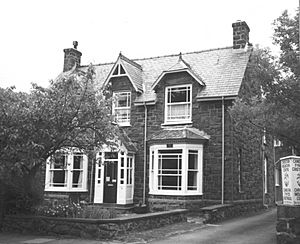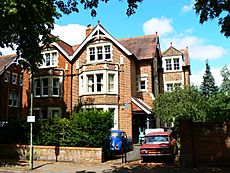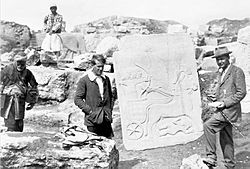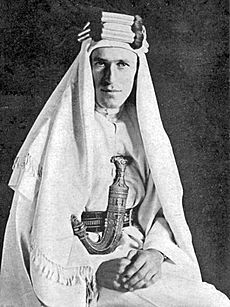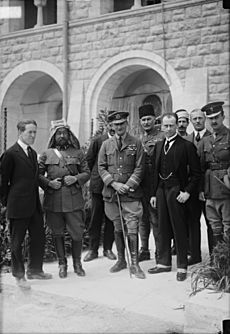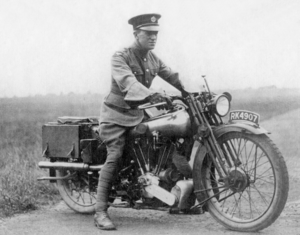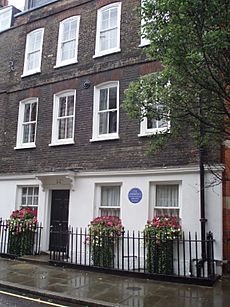T. E. Lawrence facts for kids
Quick facts for kids
T. E. Lawrence
|
|
|---|---|
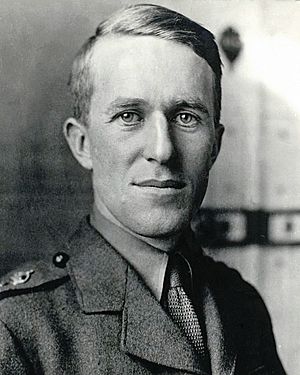
Lawrence in 1918
|
|
| Birth name | Thomas Edward Lawrence |
| Other name(s) | T. E. Shaw, John Hume Ross |
| Nickname(s) | Lawrence of Arabia |
| Born | 16 August 1888 Tremadog, Carnarvonshire, Wales |
| Died | 19 May 1935 (aged 46) Bovington Camp, Dorset, England |
| Buried |
St Nicholas, Moreton, Dorset
|
| Allegiance | United Kingdom |
| Service/ |
|
| Years of service |
|
| Rank |
|
| Battles/wars |
|
| Awards |
|
| Alma mater | Jesus College, Oxford |
Thomas Edward Lawrence (born August 16, 1888 – died May 19, 1935) was a British archaeologist, army officer, and writer. He became famous for his important role in the Arab Revolt (1916–1918). This was a fight against the Ottoman Empire during the First World War. Because of his many adventures and his amazing writing, he became known as Lawrence of Arabia. This name was also used for a famous 1962 film about his wartime experiences.
Lawrence was born in Wales. He later studied history at Jesus College, Oxford. From 1910 to 1914, he worked as an archaeologist in the Middle East. When World War I began in 1914, he joined the British Army. He was sent to Egypt to work in military intelligence. In 1916, he joined the Arab Revolt. He helped the Arab forces fight for independence from the Ottoman Empire. He worked closely with Emir Faisal, a leader of the revolt. Their efforts led to the capture of Damascus in October 1918.
After the war, Lawrence worked with the British government and Faisal. In 1922, he left public life. He spent many years serving as an enlisted man in the Royal Air Force (RAF). During this time, he wrote his most famous book, Seven Pillars of Wisdom. This book tells the story of his time in the Arab Revolt. He also translated books and wrote The Mint, about his RAF experiences. Lawrence died in 1935, at age 46, after a motorcycle accident.
Contents
Early Life and Education
Thomas Edward Lawrence was born on August 16, 1888, in Tremadog, Wales. His family moved several times when he was young. They lived in Scotland, France, and Jersey. From 1894 to 1896, they lived at Langley Lodge in Hampshire, England. This isolated home gave young Lawrence many chances to explore outdoors.
In 1896, his family moved to 2 Polstead Road in Oxford. They lived there until 1921. Lawrence went to the City of Oxford High School for Boys from 1896 to 1907. One of the school's houses was later named "Lawrence" in his honor.
Exploring Ancient Places
When he was 15, Lawrence and his friend Cyril Beeson explored churches in England. They studied old monuments and made rubbings of brasses. They also found ancient items at building sites in Oxford. They gave these finds to the Ashmolean Museum. The museum praised them for finding "everything of antiquarian value."
In the summers of 1906 and 1907, Lawrence cycled through France. He collected photos and drawings of medieval castles. From 1907 to 1910, he studied history at Jesus College, Oxford. In 1909, he walked alone for three months to visit crusader castles in Ottoman Syria. He walked about 1,000 miles. He wrote his final paper on how the Crusades influenced European military buildings.
In 1910, Lawrence became an archaeologist for the British Museum. He worked at Carchemish in northern Syria until 1914. He learned Arabic there. He worked with famous archaeologists like D. G. Hogarth and Leonard Woolley. Lawrence later said that Hogarth taught him everything important.
In January 1914, Lawrence and Woolley helped the British military. They pretended to be archaeologists while surveying the Negev Desert. This area was important because an Ottoman army might cross it to attack Egypt. They mapped the area, noting water sources and other military details.
Joining the Military
After World War I began in August 1914, Lawrence joined the British Army in October. He was made a temporary second lieutenant-interpreter. By December 1914, he was called to Cairo, Egypt. He joined the new Arab Bureau intelligence unit. His mentor, David Hogarth, was in charge.
The situation in 1915 was complicated. Many Arabs in the Ottoman lands wanted independence. Sharif Hussein, the Emir of Mecca, was talking with the British. He offered to lead an Arab uprising against the Ottomans. In return, he wanted Britain to promise an independent Arab state. This state would include the Hejaz, Syria, and Mesopotamia. An uprising would help Britain fight the Ottomans and protect the Suez Canal.
At the Arab Bureau, Lawrence made maps and interviewed prisoners. He believed in an independent Arab Syria. In October 1915, Sharif Hussein demanded a promise from Britain. Britain replied with a letter that mostly agreed, but kept some areas like the Mediterranean coast for themselves.
In spring 1916, Lawrence went to Mesopotamia. He tried to help relieve the Siege of Kut by starting an Arab uprising or bribing Ottoman officials. This mission did not succeed. Meanwhile, the Sykes–Picot Agreement was being secretly planned in London. This agreement would give a large part of Syria to France. It also meant Arabs would have to conquer major cities like Damascus themselves. It's not clear when Lawrence found out about this secret agreement.
The Arab Revolt
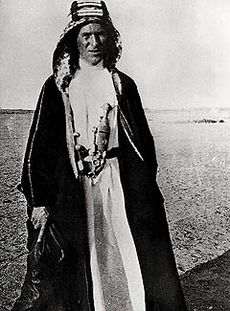
The Arab Revolt started in June 1916. But it soon faced difficulties. Ottoman forces might recapture Mecca. So, on October 16, 1916, Lawrence was sent to the Hejaz. He met Sharif Hussein's sons. He decided that Faisal was the best leader for the revolt.
In November, Lawrence was sent to work with Faisal's staff. In late December 1916, Faisal and Lawrence made a plan. They would move Arab forces to threaten the railway from Syria. This would stop Ottoman forces around Medina from attacking Arab positions. Faisal asked for Lawrence to stay permanently.
Lawrence helped the Arab Revolt with strategy and working with British forces. He also took part in many battles:
- January 3, 1917: Attacked an Ottoman outpost.
- March 26, 1917: Attacked the railway.
- July 2, 1917: Defeated Ottoman forces at Aba el Lissan, near Aqaba.
- September 27, 1917: Attacked the railway and destroyed an engine.
- November 7, 1917: Blew up a train on the railway between Dera'a and Amman. He was injured in the explosion.
- January 25–26, 1918: The Battle of Tafilah. This was a great victory for the Arab forces. Lawrence was given an award and promoted for his leadership.
- September 26, 1918: Attacked retreating Ottomans and Germans near Tafas. There was a violent conflict, and prisoners were killed.
In June 1917, Lawrence traveled 300 miles north towards Aqaba. He met Arab nationalists. He told them to wait for Faisal's forces before revolting. He also attacked a bridge to make it seem like guerrilla fighters were active. The British found his information very useful. He was promoted to major.
Lawrence often traveled between British headquarters and Faisal. He helped coordinate military actions. By early 1918, Lawrence focused mainly on raids and gathering information.
Arab Strategy
Faisal and Lawrence decided not to capture Medina. Instead, they would move north through Maan and Dera'a to Damascus. Lawrence convinced Faisal to avoid regular, large-scale attacks.
Medina was an important religious site. Its Ottoman army was weak. But it was better to leave them there. This forced the Ottomans to use many soldiers to defend and repair the Hejaz railway. This kept Ottoman troops busy and away from other battles.
Capturing Aqaba
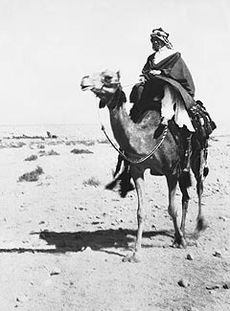
In 1917, Lawrence suggested a plan to attack Aqaba. This town was important but not well defended. It could be attacked from the sea. But the mountain passes leading to it were strongly guarded. So, Lawrence planned a surprise attack from inland.
Lawrence did not tell his British leaders all the details. He feared they would stop the plan because of French interests. The expedition left on May 9. Aqaba fell to the Arab forces on July 6. The Turkish defenses were surprised by the attack from behind. After Aqaba, General Sir Edmund Allenby, the new British commander, agreed to Lawrence's strategy.
The Fall of Damascus
Lawrence helped plan the capture of Damascus in the final weeks of the war. He arrived in Damascus around 9 AM on October 1, 1918, after the city had already fallen. The first to arrive was the 10th Light Horse Regiment.
Lawrence helped set up a temporary Arab government in Damascus. He hoped this would be the capital of an independent Arab state. However, Faisal's rule ended in 1920. French forces entered Damascus, ending Lawrence's dream of an independent Arabia.
During the war, Lawrence tried to convince British leaders that Arab independence was good for Britain. But he had mixed success. The secret Sykes-Picot Agreement between France and Britain went against the promises of independence he had made to the Arabs. This made his work difficult.
After the War
Lawrence returned to the United Kingdom as a full colonel. After the war, he worked for the Foreign Office. He attended the Paris Peace Conference from January to May 1919. He was part of Faisal's group.
In 1918, American journalist Lowell Thomas met Lawrence in Jerusalem. Thomas was fascinated by Lawrence in his Arab uniform. Thomas and his cameraman filmed and photographed Lawrence. Thomas created a stage show called With Allenby in Palestine. It showed the Middle East as exciting and mysterious.
The show opened in New York in March 1919. Thomas brought it to England. It opened in London on August 14, 1919. At first, Lawrence was a small part of the show. But Thomas realized people loved the photos of Lawrence in Arab clothes. So, he took more photos of Lawrence in London. Thomas then renamed his show With Allenby in Palestine and Lawrence in Arabia in early 1920. This new show was very popular. It made Lawrence a household name. Lawrence helped Thomas with the show, but later regretted being so famous from it.

Lawrence worked as an advisor to Winston Churchill at the Colonial Office for about a year starting in February 1920. He did not like office work. He traveled to the Middle East many times during this period. He wrote articles for newspapers to promote his ideas for the Middle East.
Lawrence admired how air power was used in the war. In August 1922, he joined the Royal Air Force (RAF) as an aircraftman. He used the name John Hume Ross. He was forced to leave the RAF in February 1923 when his true identity was revealed. He then changed his name to T. E. Shaw and joined the Royal Tank Corps later that year. He was unhappy there and asked to rejoin the RAF. They let him back in August 1925.
More publicity came after his book Revolt in the Desert was published. This led to him being sent to bases in British India (now Pakistan) in late 1926. He stayed there until the end of 1928. He had to return to Britain because of rumors about him.
Lawrence continued to serve in the RAF. He worked on high-speed boats. He was happy in this role. He left the service in March 1935. He had seen a seaplane crew drown because the rescue boat was too slow. This made him work with the British Power Boat Company to develop faster rescue boats. These boats could go up to 29 knots (about 33 miles per hour).
Death and Legacy
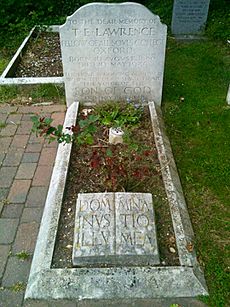
Lawrence loved motorcycles. He owned eight Brough Superior motorcycles. His last one is now in a museum. On May 13, 1935, Lawrence was in a serious motorcycle accident in Dorset. This happened near his cottage, Clouds Hill. He swerved to avoid two boys on bicycles, lost control, and was thrown off his bike. He died six days later, on May 19, 1935, at age 46. A small memorial marks the crash site. One of the doctors who treated him, Hugh Cairns, later studied head injuries from motorcycle accidents. His research led to the use of crash helmets for motorcyclists.
Lawrence was buried in the family plot of his cousins at St Nicholas' Church, Moreton. Many famous people attended his funeral, including Winston Churchill. Churchill said Lawrence's "pace of life was faster and more intense than what is normal."
Writings
Lawrence wrote a lot throughout his life. He sent many letters every day. Several collections of his letters have been published. He wrote to many famous people, including George Bernard Shaw and Winston Churchill.
Lawrence spoke French and Arabic well. He could also read Latin and Ancient Greek. He published three main books during his life. The most important was Seven Pillars of Wisdom, which tells about his part in the Arab Revolt. He also translated Homer's Odyssey and a French novel called The Forest Giant.
Seven Pillars of Wisdom
Lawrence's main work is Seven Pillars of Wisdom. It is his story of the war. He rewrote the book three times. Some parts of the book also discuss military strategy and Arab culture.
There have been claims that Lawrence made up parts of Seven Pillars. However, many of these claims have been proven wrong. For example, Lawrence claimed he crossed the Sinai Peninsula in 49 hours without sleep. But his own notes show it took over 70 hours with two long sleep breaks.
The first edition of the book was published in 1926. It was a very expensive private edition. Lawrence did not want to make money from the book. He said he wrote it because of his war service. He did not take any money from it. In fact, he ended up in debt because the cost to make the book was more than its sale price.
Revolt in the Desert
Revolt in the Desert was a shorter version of Seven Pillars. Lawrence started it in 1926, and it was published in March 1927. It became a best-seller. Again, Lawrence did not take any money from it. He wanted to be fair to those who paid a lot for the first edition of Seven Pillars. The money from Revolt in the Desert helped pay off his debt.
Lawrence set up the "Seven Pillars Trust" with his friend D. G. Hogarth. He gave the copyright and any extra money from Revolt in the Desert to this trust. The trust used the money to help children of RAF officers and the RAF Benevolent Fund.
Published After His Death
Lawrence left a book called The Mint unpublished. It is about his time as an enlisted man in the RAF. He wrote about the daily lives of soldiers. This book is written in a simpler style than Seven Pillars. His brother Arnold edited and published it after Lawrence's death.
After Lawrence died, his brother Arnold inherited his writings. Arnold sold the US copyright of Seven Pillars of Wisdom to pay inheritance taxes. He also set up two trusts to manage Lawrence's other writings. These trusts helped fund the RAF Benevolent Fund and other projects.
Other Writings
- Arab Memorandum to the Paris Peace Conference (1919)
- Seven Pillars of Wisdom, his main book about the Arab Revolt.
- Revolt in the Desert, a shorter version of Seven Pillars of Wisdom.
- The Mint, about his time in the Royal Air Force.
- Crusader Castles, his Oxford university paper.
- The Odyssey of Homer, his translation from Greek.
- The Forest Giant, a novel he translated from French.
- The Letters of T. E. Lawrence, collections of his letters.
- Guerrilla Warfare, an article he wrote for the Encyclopædia Britannica.
- The Wilderness of Zin, a report he wrote with C. Leonard Woolley.
- Oriental Assembly (1939)
Awards and Honors
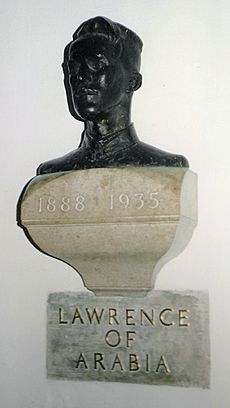
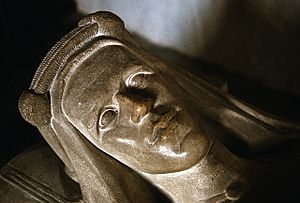
Lawrence received several awards for his service. He was made a Companion of the Order of the Bath in 1917. He also received the Distinguished Service Order in 1918. France awarded him the Knight of the Legion of Honour in 1916 and the Croix de guerre in 1918.
In October 1918, King George V offered Lawrence a knighthood. This was for his work in the Arab Revolt. But Lawrence refused the honor. He felt his country had not kept its promises to the Arabs.
A bronze statue of Lawrence by Eric Kennington is in St Paul's Cathedral, London. It is placed near the tombs of other great British military leaders. Another stone statue by Kennington is in St Martin's Church, Wareham, Dorset.
An English Heritage blue plaque marks Lawrence's childhood home in Oxford. Another is on his London home. In 2002, Lawrence was voted 53rd in the BBC's list of the 100 Greatest Britons. In 2018, he was featured on a special £5 coin to mark 100 years since the First World War.
See also
 In Spanish: Thomas Edward Lawrence para niños
In Spanish: Thomas Edward Lawrence para niños
- Hashemites, the ruling family of Mecca and Jordan
- Kingdom of Iraq (1932–1958)
- Lawrence of Arabia: The Authorised Biography of T. E. Lawrence by Jeremy Wilson (1989)
- The Adventures of Young Indiana Jones, a TV series that shows parts of Lawrence's life
Related people
- Richard Meinertzhagen (1878–1967), a British intelligence officer who worked with Lawrence
- Rafael de Nogales Méndez (1879–1937), a Venezuelan officer compared to Lawrence
- Suleiman Mousa (1919–2008), a Jordanian historian who wrote about Lawrence
- Oskar von Niedermayer (1885–1948), a German officer sometimes called the "German Lawrence"
- Max von Oppenheim (1860–1946), a German archaeologist whose book Lawrence admired
- Wilhelm Wassmuss (1880–1931), a German diplomat compared to Lawrence


